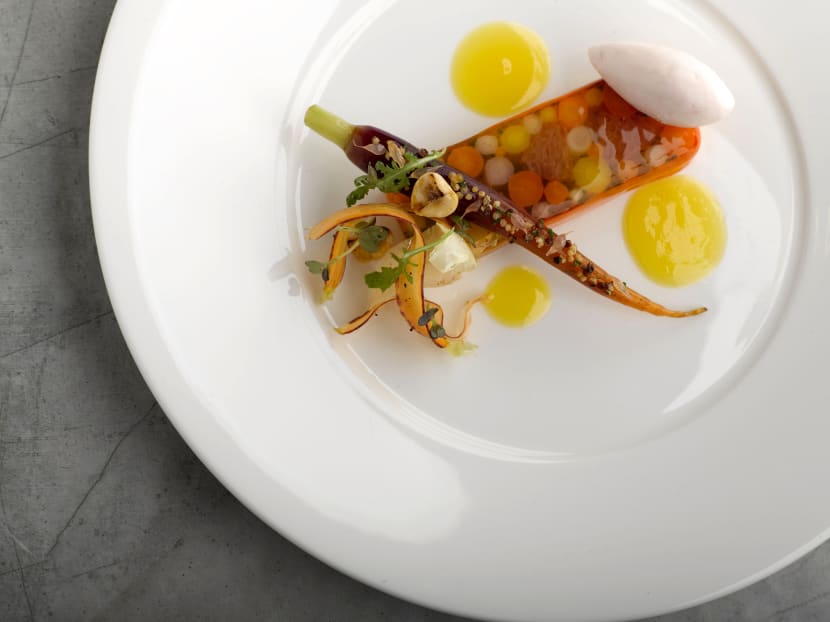Singapore team shares how they managed to clinch gold at Culinary Olympics
The team scored gold in two categories. Coming up with the dishes was a long process, taking about a year, and each dish was fine-tuned right up until the day before the competition.


SINGAPORE — After being crowned the overall champion of the Culinary Olympics 2016 for the first time, it was only natural that the members of Singapore’s National Culinary Team celebrated their feat with corresponding gusto.
And celebrate they did. “The team went to a German restaurant and had a great German feast, drank lots of German beer, finally relaxed, had a good time — and slept peacefully after,” said team captain Teo Yeow Siang from Lavish Catering.
“We were sleep-deprived the last few days because we worked throughout the night for the Cold Display — eight hours — and the following day, we were on our feet for 10 hours straight for the Hot Cooking segment.”
The competition, held in Erfurt, Germany, last week, consists of two parts, explained the team’s manager Louis Tay (executive chef at Swissotel Merchant Court). The first is the Cold Display, where the team is tasked to set up an exhibition table comprising four varieties of finger foods for six, a cold festive platter for eight, three starters for one, a vegetarian three-course lunch menu for one, and a festive menu for one. The pastry set-up includes a show item, four individual plated desserts and a display of sweet biscuits, chocolates and petit fours.
These foods (coated in aspic, a type of jelly) are not tasted by the judges, Tay explained. “Instead, points are awarded for menu composition, fine work on the plates and consistency.”
The Hot Cooking programme, on the other hand, required teams to cook 100 servings of a three-course meal in only five hours. All ingredients must be prepared at the competition kitchen, and points are awarded for taste, presentation and skill level.
The team went on to score gold in both categories. And while it would be hard to pick out their most memorable dishes, there were a couple that stood out, Teo shared. “Everyone loved the appetiser as it’s a very tasty dish with different textures and colours,” he said in reference to the course of Scottish salmon with cauliflower glaze and smoked scallop, next to Maine lobster cooked in squid ink batter and served with a salad of snap peas and radish.
“The rabbit roulade has to be the hardest to execute as we used three different ingredients in the roulade, (and) each of the ingredients needed a different cooking time,” he added.
Coming up with the dishes was an even longer process, taking about a year, said Tay, who also pointed out how they took about four months to come up with the main component for each dish, which they kept fine-tuning right up until the day before the competition.
But why rabbit? “In the 2014 Culinary World Cup, we prepared a pigeon dish; no team had ever cooked a pigeon dish in the competition, and we won that year,” he explained. “So we thought we needed to come up with something that could ‘wow’ — so we decided to prepare rabbit this time round.
“We trained with frozen rabbit in Singapore, and trained three times with the fresh rabbit from Europe on location.”
A PART TO PLAY
A team, it is often said, is only as strong as its weakest link. And it is obvious every member of this year’s Singapore National Culinary Team did more than pull his or her weight.
“Skills, knowledge and experience aside, it is crucial that the member has his or her heart in the right place,” said chef-lecturer Randy Chow of the Singapore Chefs Association, who is overall-in-charge of the competitions that the national team undertakes.
The Singapore Chefs Association’s competition committee looks at candidates’ past competition results, and picks members based on their level of technique, creativity and aptitude.
“Attitude, integrity and the ability to work well with others are vital,” he added, before affirming one particularly difficult aspect. “A knowledgeable pastry chef with good competition experience is very hard to come by; we are lucky to have a very good pastry mentor in Kenny Kong (Resorts World Sentosa’s executive pastry chef), whose input has been invaluable,” he continued.
Other chef-mentors include Eric Teo (ET Culinary Arts), Yen Koh (Unilever Food Solutions, Southeast Asia), Yew Eng Tong (Ocean Restaurant by Cat Cora, Resorts World Sentosa), Edmund Toh (Shatec Institutes), Ivan Yeo (SATS Catering), Anderson Ho (Snorre Food) and Eric Ong (Park Hotel Group).
Humility and grit, Tay added, are equally crucial virtues. Spending “countless hours” in the kitchen perfecting the dish is one thing, but juggling work and family commitments at the same time can be challenging.
“The team usually worked overnight whenever we had a presentation (to our mentors),” he said. “Also, three of the team members became new dads (chefs Triston Fang, Alan Wong and Alex Chong) a few months before the competition. It was challenging for them to be away from home and focus on the training.”
The process, which Tay described as painful at times, also took a toll on the ego. The critiques from the mentors were tough, and they had to constantly remind themselves to stay humble. “For example, pastry, which got a lot of criticism, improved tremendously at our last training session in Singapore and eventually helped pull up our overall scores. It’s like a race — you never know the result till the end.”








